University Report: Qualitative Research Methods and HR Case Study
VerifiedAdded on 2020/04/21
|10
|2120
|75
Report
AI Summary
This report presents a case study analysis of qualitative research methods, specifically focusing on HR practices within an organization. The study explores the use of pilot case studies to refine data collection plans and identifies various sources of evidence, including documentation, interviews, and archival records. The report details the data analysis process, utilizing MAXQDA software to examine the correlation between HR practices, employee performance, and knowledge. The findings reveal a moderate and statistically significant correlation between HR practices and employee outcomes, as well as between management practices and employee knowledge. The analysis also considers the internal consistency of the data using Cronbach's alpha. The conclusion summarizes the key findings and discusses the value of the case study method in understanding organizational behavior and human resource management.
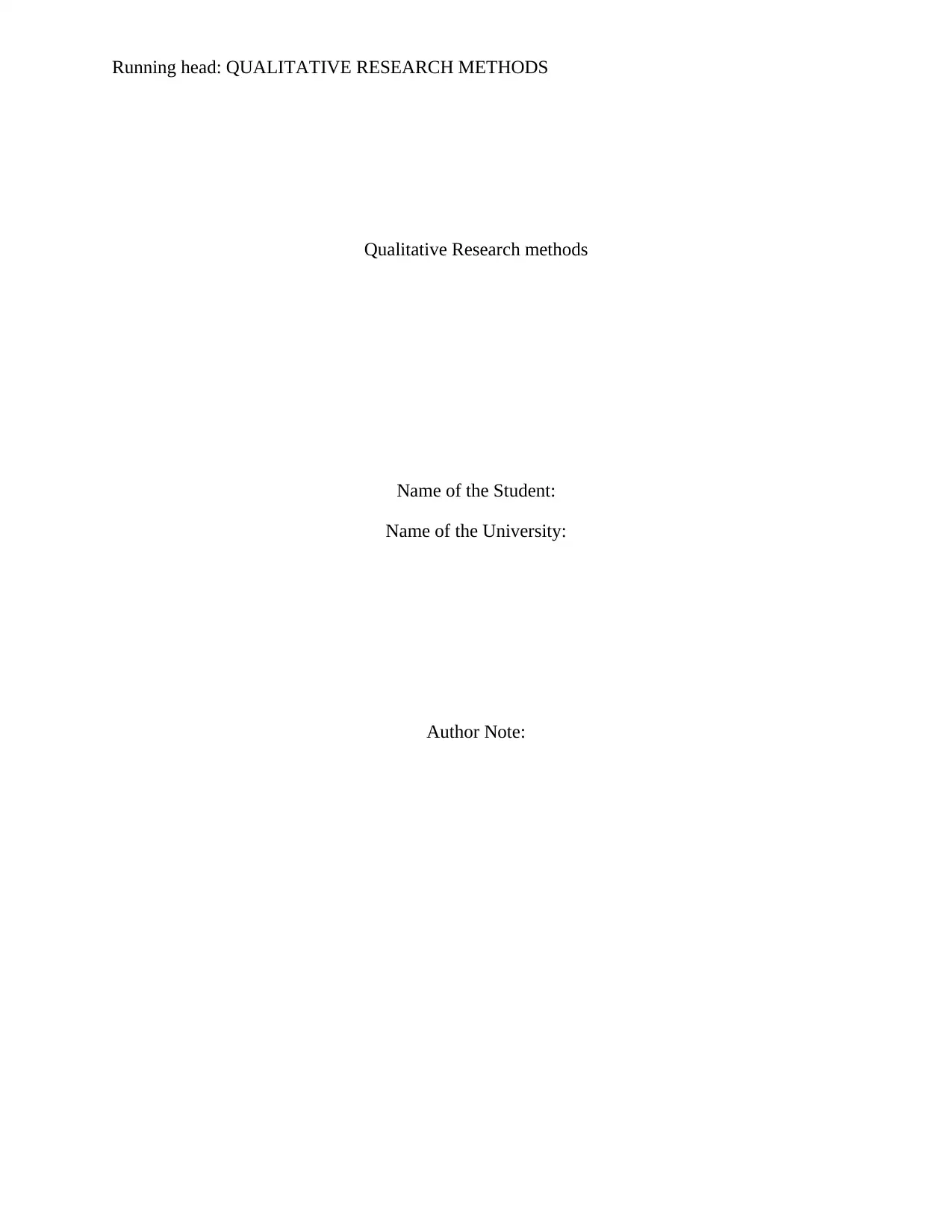
Running head: QUALITATIVE RESEARCH METHODS
Qualitative Research methods
Name of the Student:
Name of the University:
Author Note:
Qualitative Research methods
Name of the Student:
Name of the University:
Author Note:
Paraphrase This Document
Need a fresh take? Get an instant paraphrase of this document with our AI Paraphraser
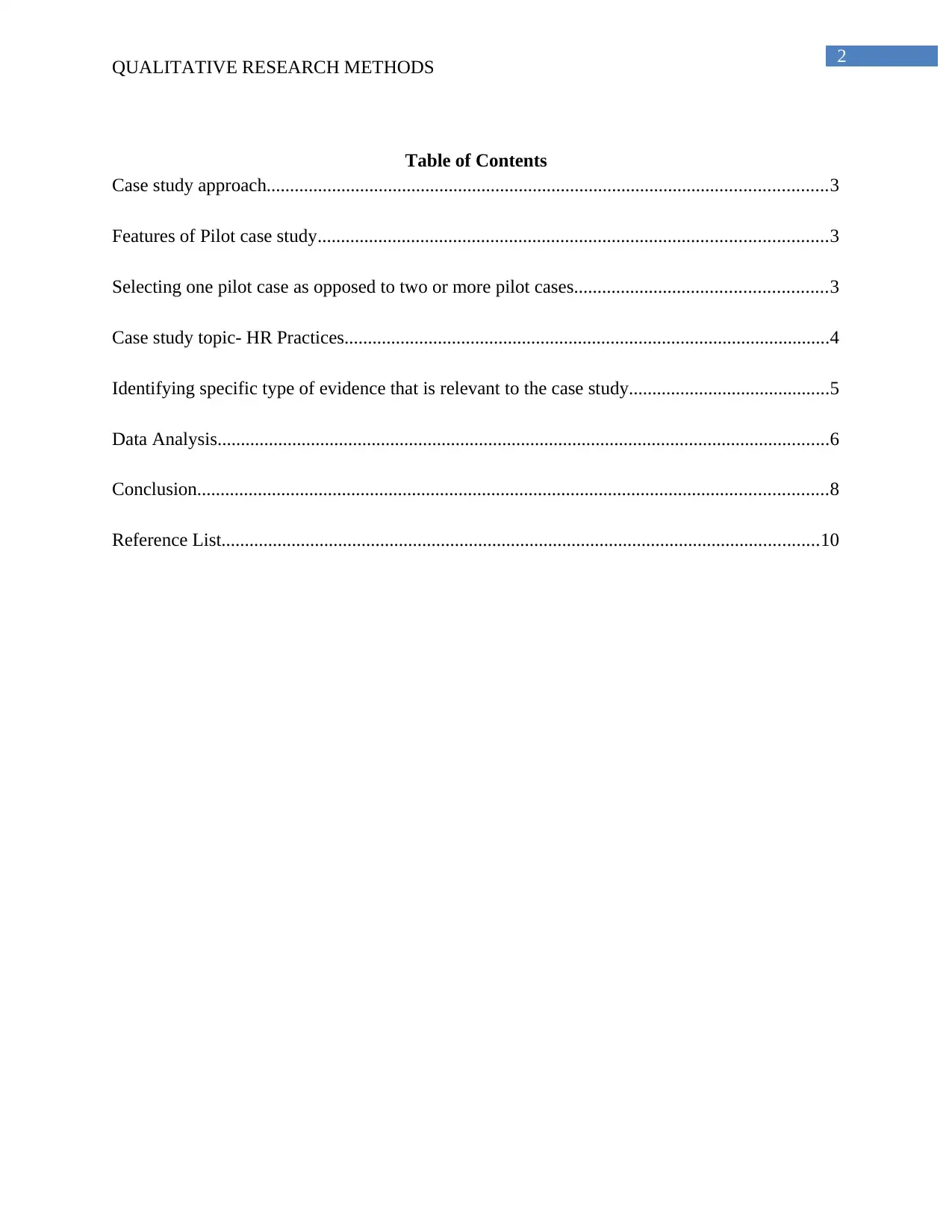
2
QUALITATIVE RESEARCH METHODS
Table of Contents
Case study approach........................................................................................................................3
Features of Pilot case study.............................................................................................................3
Selecting one pilot case as opposed to two or more pilot cases......................................................3
Case study topic- HR Practices........................................................................................................4
Identifying specific type of evidence that is relevant to the case study...........................................5
Data Analysis...................................................................................................................................6
Conclusion.......................................................................................................................................8
Reference List................................................................................................................................10
QUALITATIVE RESEARCH METHODS
Table of Contents
Case study approach........................................................................................................................3
Features of Pilot case study.............................................................................................................3
Selecting one pilot case as opposed to two or more pilot cases......................................................3
Case study topic- HR Practices........................................................................................................4
Identifying specific type of evidence that is relevant to the case study...........................................5
Data Analysis...................................................................................................................................6
Conclusion.......................................................................................................................................8
Reference List................................................................................................................................10
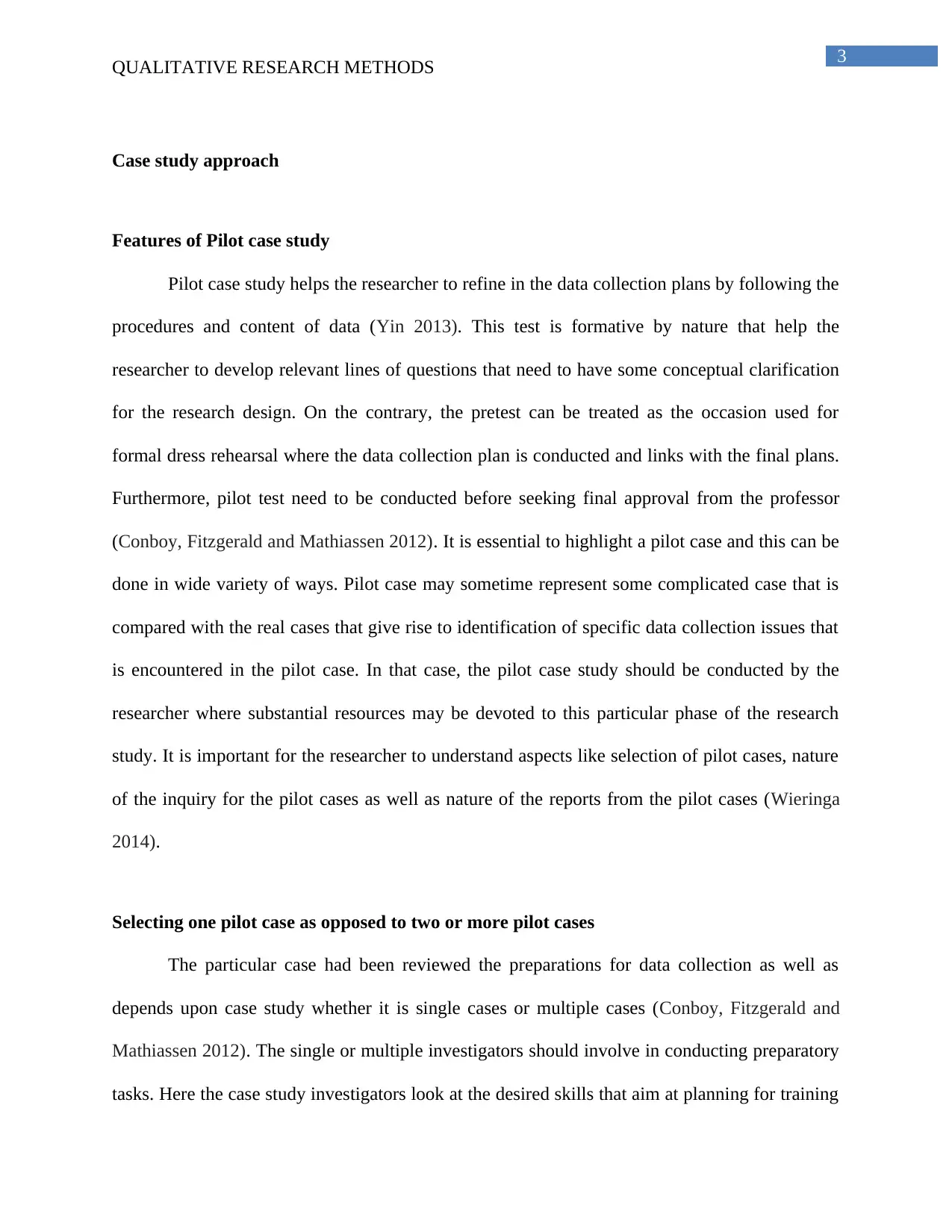
3
QUALITATIVE RESEARCH METHODS
Case study approach
Features of Pilot case study
Pilot case study helps the researcher to refine in the data collection plans by following the
procedures and content of data (Yin 2013). This test is formative by nature that help the
researcher to develop relevant lines of questions that need to have some conceptual clarification
for the research design. On the contrary, the pretest can be treated as the occasion used for
formal dress rehearsal where the data collection plan is conducted and links with the final plans.
Furthermore, pilot test need to be conducted before seeking final approval from the professor
(Conboy, Fitzgerald and Mathiassen 2012). It is essential to highlight a pilot case and this can be
done in wide variety of ways. Pilot case may sometime represent some complicated case that is
compared with the real cases that give rise to identification of specific data collection issues that
is encountered in the pilot case. In that case, the pilot case study should be conducted by the
researcher where substantial resources may be devoted to this particular phase of the research
study. It is important for the researcher to understand aspects like selection of pilot cases, nature
of the inquiry for the pilot cases as well as nature of the reports from the pilot cases (Wieringa
2014).
Selecting one pilot case as opposed to two or more pilot cases
The particular case had been reviewed the preparations for data collection as well as
depends upon case study whether it is single cases or multiple cases (Conboy, Fitzgerald and
Mathiassen 2012). The single or multiple investigators should involve in conducting preparatory
tasks. Here the case study investigators look at the desired skills that aim at planning for training
QUALITATIVE RESEARCH METHODS
Case study approach
Features of Pilot case study
Pilot case study helps the researcher to refine in the data collection plans by following the
procedures and content of data (Yin 2013). This test is formative by nature that help the
researcher to develop relevant lines of questions that need to have some conceptual clarification
for the research design. On the contrary, the pretest can be treated as the occasion used for
formal dress rehearsal where the data collection plan is conducted and links with the final plans.
Furthermore, pilot test need to be conducted before seeking final approval from the professor
(Conboy, Fitzgerald and Mathiassen 2012). It is essential to highlight a pilot case and this can be
done in wide variety of ways. Pilot case may sometime represent some complicated case that is
compared with the real cases that give rise to identification of specific data collection issues that
is encountered in the pilot case. In that case, the pilot case study should be conducted by the
researcher where substantial resources may be devoted to this particular phase of the research
study. It is important for the researcher to understand aspects like selection of pilot cases, nature
of the inquiry for the pilot cases as well as nature of the reports from the pilot cases (Wieringa
2014).
Selecting one pilot case as opposed to two or more pilot cases
The particular case had been reviewed the preparations for data collection as well as
depends upon case study whether it is single cases or multiple cases (Conboy, Fitzgerald and
Mathiassen 2012). The single or multiple investigators should involve in conducting preparatory
tasks. Here the case study investigators look at the desired skills that aim at planning for training
⊘ This is a preview!⊘
Do you want full access?
Subscribe today to unlock all pages.

Trusted by 1+ million students worldwide
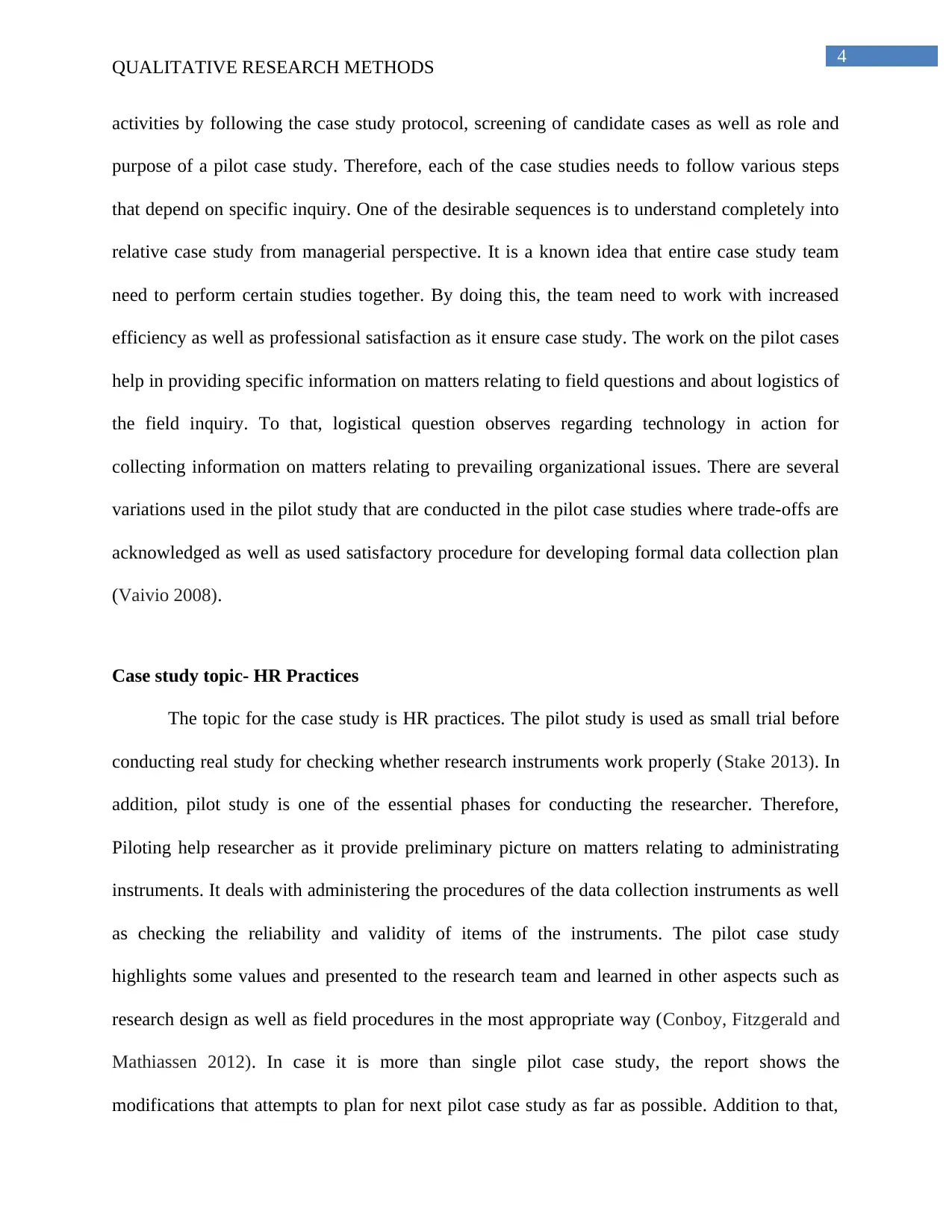
4
QUALITATIVE RESEARCH METHODS
activities by following the case study protocol, screening of candidate cases as well as role and
purpose of a pilot case study. Therefore, each of the case studies needs to follow various steps
that depend on specific inquiry. One of the desirable sequences is to understand completely into
relative case study from managerial perspective. It is a known idea that entire case study team
need to perform certain studies together. By doing this, the team need to work with increased
efficiency as well as professional satisfaction as it ensure case study. The work on the pilot cases
help in providing specific information on matters relating to field questions and about logistics of
the field inquiry. To that, logistical question observes regarding technology in action for
collecting information on matters relating to prevailing organizational issues. There are several
variations used in the pilot study that are conducted in the pilot case studies where trade-offs are
acknowledged as well as used satisfactory procedure for developing formal data collection plan
(Vaivio 2008).
Case study topic- HR Practices
The topic for the case study is HR practices. The pilot study is used as small trial before
conducting real study for checking whether research instruments work properly (Stake 2013). In
addition, pilot study is one of the essential phases for conducting the researcher. Therefore,
Piloting help researcher as it provide preliminary picture on matters relating to administrating
instruments. It deals with administering the procedures of the data collection instruments as well
as checking the reliability and validity of items of the instruments. The pilot case study
highlights some values and presented to the research team and learned in other aspects such as
research design as well as field procedures in the most appropriate way (Conboy, Fitzgerald and
Mathiassen 2012). In case it is more than single pilot case study, the report shows the
modifications that attempts to plan for next pilot case study as far as possible. Addition to that,
QUALITATIVE RESEARCH METHODS
activities by following the case study protocol, screening of candidate cases as well as role and
purpose of a pilot case study. Therefore, each of the case studies needs to follow various steps
that depend on specific inquiry. One of the desirable sequences is to understand completely into
relative case study from managerial perspective. It is a known idea that entire case study team
need to perform certain studies together. By doing this, the team need to work with increased
efficiency as well as professional satisfaction as it ensure case study. The work on the pilot cases
help in providing specific information on matters relating to field questions and about logistics of
the field inquiry. To that, logistical question observes regarding technology in action for
collecting information on matters relating to prevailing organizational issues. There are several
variations used in the pilot study that are conducted in the pilot case studies where trade-offs are
acknowledged as well as used satisfactory procedure for developing formal data collection plan
(Vaivio 2008).
Case study topic- HR Practices
The topic for the case study is HR practices. The pilot study is used as small trial before
conducting real study for checking whether research instruments work properly (Stake 2013). In
addition, pilot study is one of the essential phases for conducting the researcher. Therefore,
Piloting help researcher as it provide preliminary picture on matters relating to administrating
instruments. It deals with administering the procedures of the data collection instruments as well
as checking the reliability and validity of items of the instruments. The pilot case study
highlights some values and presented to the research team and learned in other aspects such as
research design as well as field procedures in the most appropriate way (Conboy, Fitzgerald and
Mathiassen 2012). In case it is more than single pilot case study, the report shows the
modifications that attempts to plan for next pilot case study as far as possible. Addition to that,
Paraphrase This Document
Need a fresh take? Get an instant paraphrase of this document with our AI Paraphraser
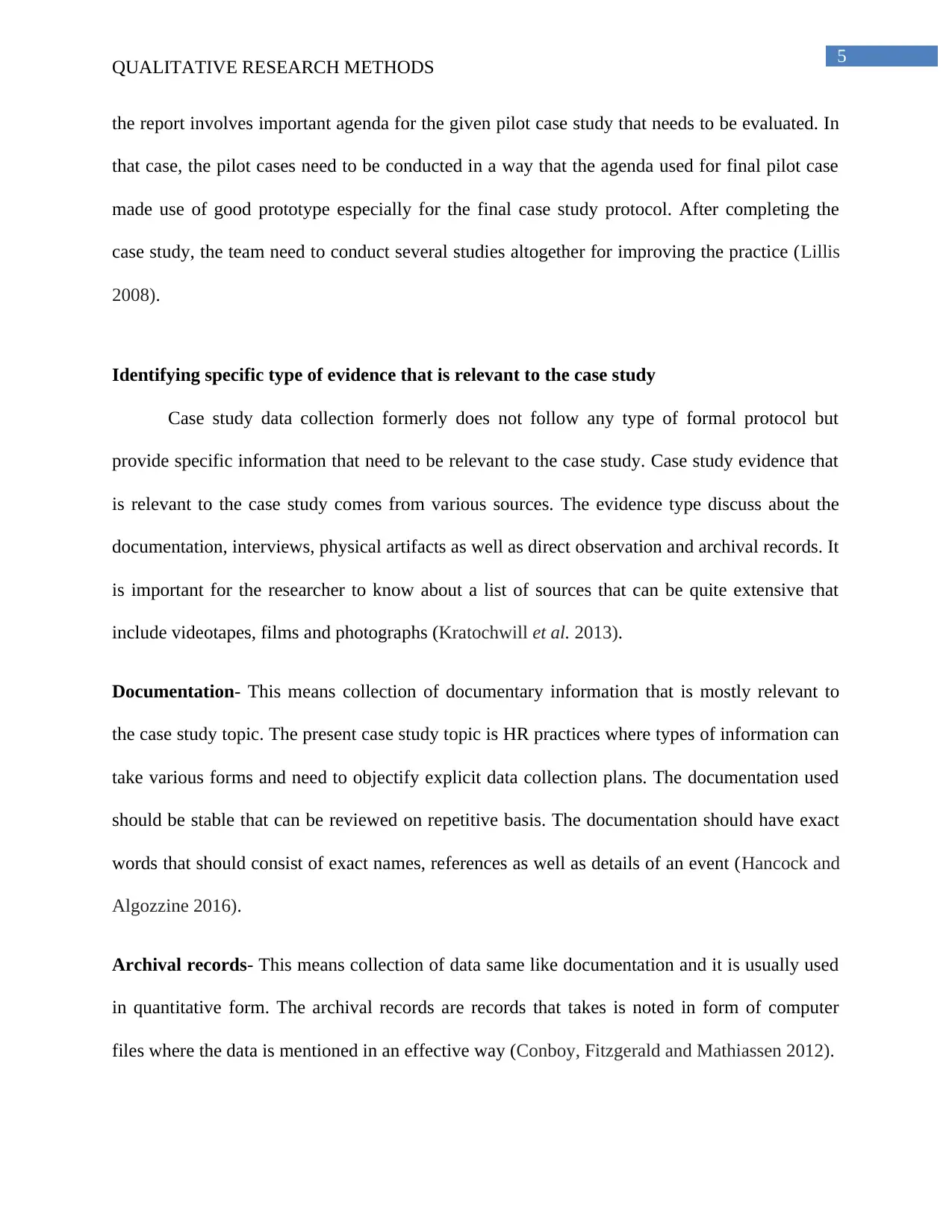
5
QUALITATIVE RESEARCH METHODS
the report involves important agenda for the given pilot case study that needs to be evaluated. In
that case, the pilot cases need to be conducted in a way that the agenda used for final pilot case
made use of good prototype especially for the final case study protocol. After completing the
case study, the team need to conduct several studies altogether for improving the practice (Lillis
2008).
Identifying specific type of evidence that is relevant to the case study
Case study data collection formerly does not follow any type of formal protocol but
provide specific information that need to be relevant to the case study. Case study evidence that
is relevant to the case study comes from various sources. The evidence type discuss about the
documentation, interviews, physical artifacts as well as direct observation and archival records. It
is important for the researcher to know about a list of sources that can be quite extensive that
include videotapes, films and photographs (Kratochwill et al. 2013).
Documentation- This means collection of documentary information that is mostly relevant to
the case study topic. The present case study topic is HR practices where types of information can
take various forms and need to objectify explicit data collection plans. The documentation used
should be stable that can be reviewed on repetitive basis. The documentation should have exact
words that should consist of exact names, references as well as details of an event (Hancock and
Algozzine 2016).
Archival records- This means collection of data same like documentation and it is usually used
in quantitative form. The archival records are records that takes is noted in form of computer
files where the data is mentioned in an effective way (Conboy, Fitzgerald and Mathiassen 2012).
QUALITATIVE RESEARCH METHODS
the report involves important agenda for the given pilot case study that needs to be evaluated. In
that case, the pilot cases need to be conducted in a way that the agenda used for final pilot case
made use of good prototype especially for the final case study protocol. After completing the
case study, the team need to conduct several studies altogether for improving the practice (Lillis
2008).
Identifying specific type of evidence that is relevant to the case study
Case study data collection formerly does not follow any type of formal protocol but
provide specific information that need to be relevant to the case study. Case study evidence that
is relevant to the case study comes from various sources. The evidence type discuss about the
documentation, interviews, physical artifacts as well as direct observation and archival records. It
is important for the researcher to know about a list of sources that can be quite extensive that
include videotapes, films and photographs (Kratochwill et al. 2013).
Documentation- This means collection of documentary information that is mostly relevant to
the case study topic. The present case study topic is HR practices where types of information can
take various forms and need to objectify explicit data collection plans. The documentation used
should be stable that can be reviewed on repetitive basis. The documentation should have exact
words that should consist of exact names, references as well as details of an event (Hancock and
Algozzine 2016).
Archival records- This means collection of data same like documentation and it is usually used
in quantitative form. The archival records are records that takes is noted in form of computer
files where the data is mentioned in an effective way (Conboy, Fitzgerald and Mathiassen 2012).
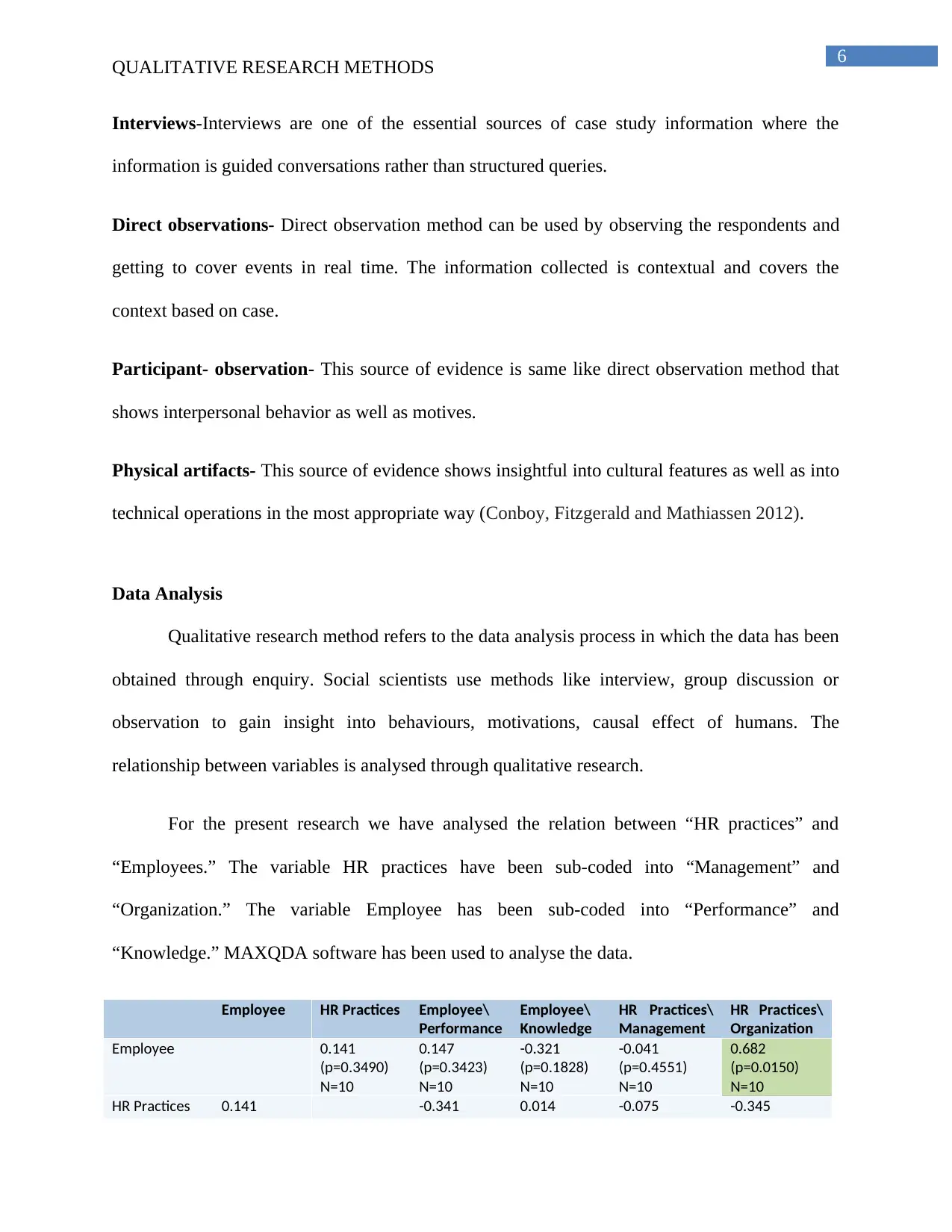
6
QUALITATIVE RESEARCH METHODS
Interviews-Interviews are one of the essential sources of case study information where the
information is guided conversations rather than structured queries.
Direct observations- Direct observation method can be used by observing the respondents and
getting to cover events in real time. The information collected is contextual and covers the
context based on case.
Participant- observation- This source of evidence is same like direct observation method that
shows interpersonal behavior as well as motives.
Physical artifacts- This source of evidence shows insightful into cultural features as well as into
technical operations in the most appropriate way (Conboy, Fitzgerald and Mathiassen 2012).
Data Analysis
Qualitative research method refers to the data analysis process in which the data has been
obtained through enquiry. Social scientists use methods like interview, group discussion or
observation to gain insight into behaviours, motivations, causal effect of humans. The
relationship between variables is analysed through qualitative research.
For the present research we have analysed the relation between “HR practices” and
“Employees.” The variable HR practices have been sub-coded into “Management” and
“Organization.” The variable Employee has been sub-coded into “Performance” and
“Knowledge.” MAXQDA software has been used to analyse the data.
Employee HR Practices Employee\
Performance
Employee\
Knowledge
HR Practices\
Management
HR Practices\
Organization
Employee 0.141
(p=0.3490)
N=10
0.147
(p=0.3423)
N=10
-0.321
(p=0.1828)
N=10
-0.041
(p=0.4551)
N=10
0.682
(p=0.0150)
N=10
HR Practices 0.141 -0.341 0.014 -0.075 -0.345
QUALITATIVE RESEARCH METHODS
Interviews-Interviews are one of the essential sources of case study information where the
information is guided conversations rather than structured queries.
Direct observations- Direct observation method can be used by observing the respondents and
getting to cover events in real time. The information collected is contextual and covers the
context based on case.
Participant- observation- This source of evidence is same like direct observation method that
shows interpersonal behavior as well as motives.
Physical artifacts- This source of evidence shows insightful into cultural features as well as into
technical operations in the most appropriate way (Conboy, Fitzgerald and Mathiassen 2012).
Data Analysis
Qualitative research method refers to the data analysis process in which the data has been
obtained through enquiry. Social scientists use methods like interview, group discussion or
observation to gain insight into behaviours, motivations, causal effect of humans. The
relationship between variables is analysed through qualitative research.
For the present research we have analysed the relation between “HR practices” and
“Employees.” The variable HR practices have been sub-coded into “Management” and
“Organization.” The variable Employee has been sub-coded into “Performance” and
“Knowledge.” MAXQDA software has been used to analyse the data.
Employee HR Practices Employee\
Performance
Employee\
Knowledge
HR Practices\
Management
HR Practices\
Organization
Employee 0.141
(p=0.3490)
N=10
0.147
(p=0.3423)
N=10
-0.321
(p=0.1828)
N=10
-0.041
(p=0.4551)
N=10
0.682
(p=0.0150)
N=10
HR Practices 0.141 -0.341 0.014 -0.075 -0.345
⊘ This is a preview!⊘
Do you want full access?
Subscribe today to unlock all pages.

Trusted by 1+ million students worldwide
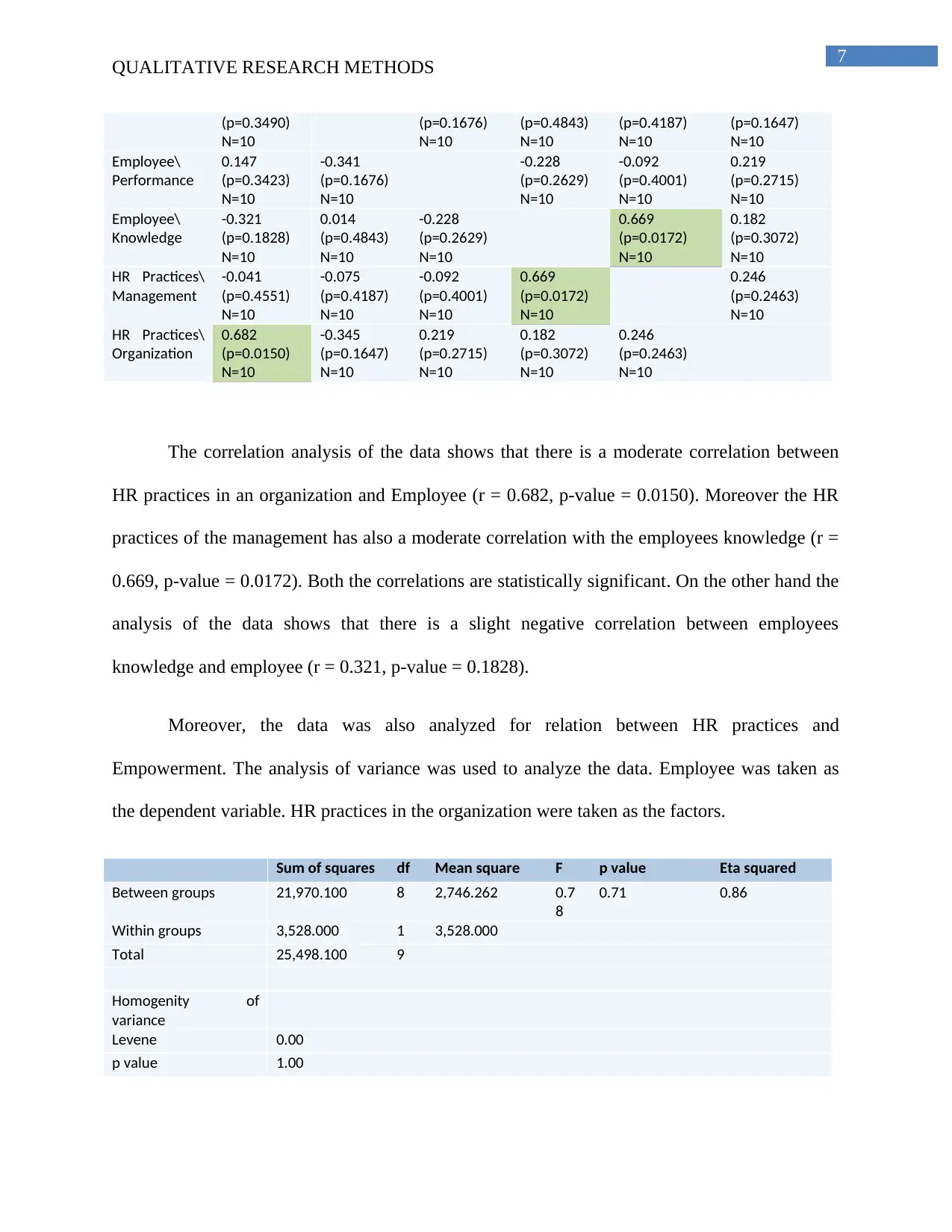
7
QUALITATIVE RESEARCH METHODS
(p=0.3490)
N=10
(p=0.1676)
N=10
(p=0.4843)
N=10
(p=0.4187)
N=10
(p=0.1647)
N=10
Employee\
Performance
0.147
(p=0.3423)
N=10
-0.341
(p=0.1676)
N=10
-0.228
(p=0.2629)
N=10
-0.092
(p=0.4001)
N=10
0.219
(p=0.2715)
N=10
Employee\
Knowledge
-0.321
(p=0.1828)
N=10
0.014
(p=0.4843)
N=10
-0.228
(p=0.2629)
N=10
0.669
(p=0.0172)
N=10
0.182
(p=0.3072)
N=10
HR Practices\
Management
-0.041
(p=0.4551)
N=10
-0.075
(p=0.4187)
N=10
-0.092
(p=0.4001)
N=10
0.669
(p=0.0172)
N=10
0.246
(p=0.2463)
N=10
HR Practices\
Organization
0.682
(p=0.0150)
N=10
-0.345
(p=0.1647)
N=10
0.219
(p=0.2715)
N=10
0.182
(p=0.3072)
N=10
0.246
(p=0.2463)
N=10
The correlation analysis of the data shows that there is a moderate correlation between
HR practices in an organization and Employee (r = 0.682, p-value = 0.0150). Moreover the HR
practices of the management has also a moderate correlation with the employees knowledge (r =
0.669, p-value = 0.0172). Both the correlations are statistically significant. On the other hand the
analysis of the data shows that there is a slight negative correlation between employees
knowledge and employee (r = 0.321, p-value = 0.1828).
Moreover, the data was also analyzed for relation between HR practices and
Empowerment. The analysis of variance was used to analyze the data. Employee was taken as
the dependent variable. HR practices in the organization were taken as the factors.
Sum of squares df Mean square F p value Eta squared
Between groups 21,970.100 8 2,746.262 0.7
8
0.71 0.86
Within groups 3,528.000 1 3,528.000
Total 25,498.100 9
Homogenity of
variance
Levene 0.00
p value 1.00
QUALITATIVE RESEARCH METHODS
(p=0.3490)
N=10
(p=0.1676)
N=10
(p=0.4843)
N=10
(p=0.4187)
N=10
(p=0.1647)
N=10
Employee\
Performance
0.147
(p=0.3423)
N=10
-0.341
(p=0.1676)
N=10
-0.228
(p=0.2629)
N=10
-0.092
(p=0.4001)
N=10
0.219
(p=0.2715)
N=10
Employee\
Knowledge
-0.321
(p=0.1828)
N=10
0.014
(p=0.4843)
N=10
-0.228
(p=0.2629)
N=10
0.669
(p=0.0172)
N=10
0.182
(p=0.3072)
N=10
HR Practices\
Management
-0.041
(p=0.4551)
N=10
-0.075
(p=0.4187)
N=10
-0.092
(p=0.4001)
N=10
0.669
(p=0.0172)
N=10
0.246
(p=0.2463)
N=10
HR Practices\
Organization
0.682
(p=0.0150)
N=10
-0.345
(p=0.1647)
N=10
0.219
(p=0.2715)
N=10
0.182
(p=0.3072)
N=10
0.246
(p=0.2463)
N=10
The correlation analysis of the data shows that there is a moderate correlation between
HR practices in an organization and Employee (r = 0.682, p-value = 0.0150). Moreover the HR
practices of the management has also a moderate correlation with the employees knowledge (r =
0.669, p-value = 0.0172). Both the correlations are statistically significant. On the other hand the
analysis of the data shows that there is a slight negative correlation between employees
knowledge and employee (r = 0.321, p-value = 0.1828).
Moreover, the data was also analyzed for relation between HR practices and
Empowerment. The analysis of variance was used to analyze the data. Employee was taken as
the dependent variable. HR practices in the organization were taken as the factors.
Sum of squares df Mean square F p value Eta squared
Between groups 21,970.100 8 2,746.262 0.7
8
0.71 0.86
Within groups 3,528.000 1 3,528.000
Total 25,498.100 9
Homogenity of
variance
Levene 0.00
p value 1.00
Paraphrase This Document
Need a fresh take? Get an instant paraphrase of this document with our AI Paraphraser
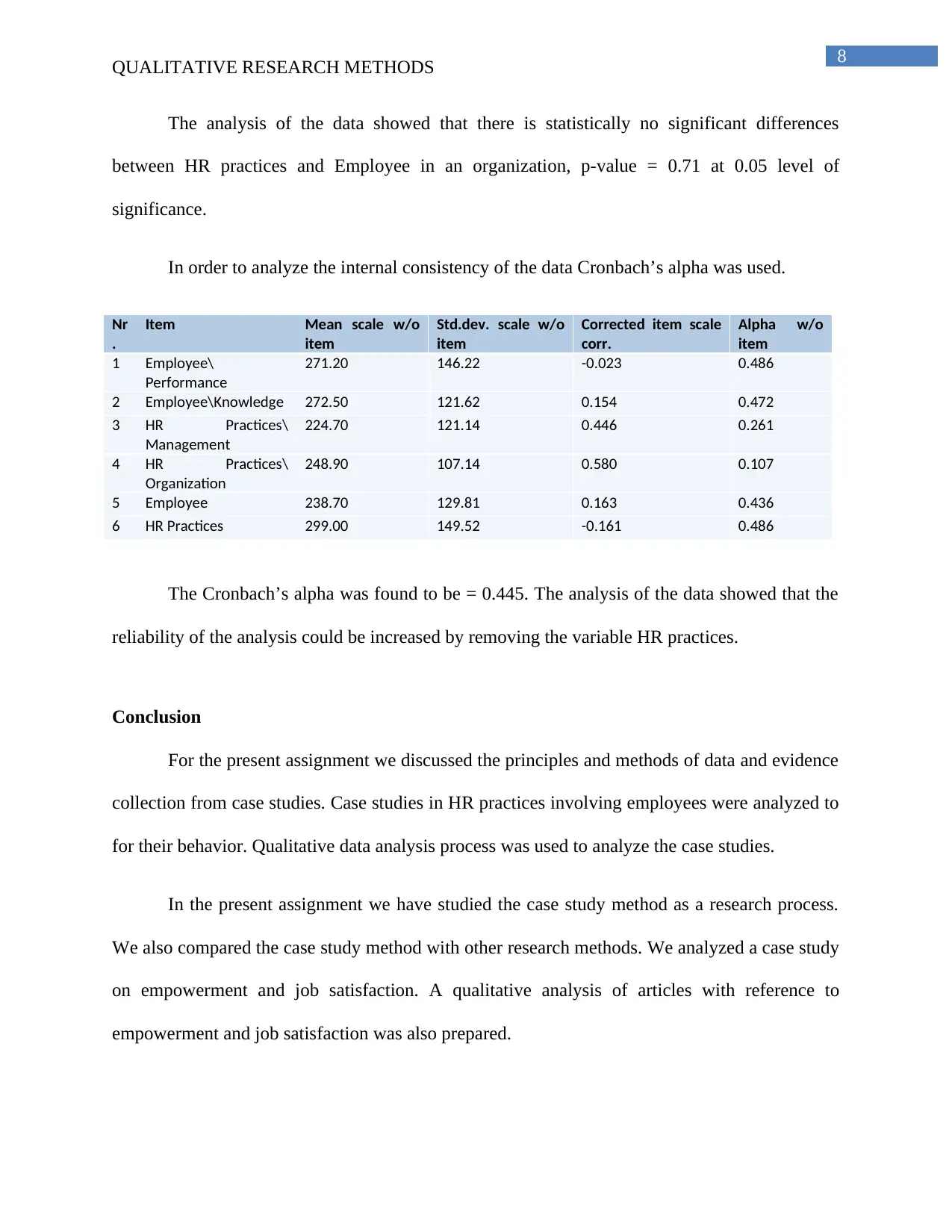
8
QUALITATIVE RESEARCH METHODS
The analysis of the data showed that there is statistically no significant differences
between HR practices and Employee in an organization, p-value = 0.71 at 0.05 level of
significance.
In order to analyze the internal consistency of the data Cronbach’s alpha was used.
Nr
.
Item Mean scale w/o
item
Std.dev. scale w/o
item
Corrected item scale
corr.
Alpha w/o
item
1 Employee\
Performance
271.20 146.22 -0.023 0.486
2 Employee\Knowledge 272.50 121.62 0.154 0.472
3 HR Practices\
Management
224.70 121.14 0.446 0.261
4 HR Practices\
Organization
248.90 107.14 0.580 0.107
5 Employee 238.70 129.81 0.163 0.436
6 HR Practices 299.00 149.52 -0.161 0.486
The Cronbach’s alpha was found to be = 0.445. The analysis of the data showed that the
reliability of the analysis could be increased by removing the variable HR practices.
Conclusion
For the present assignment we discussed the principles and methods of data and evidence
collection from case studies. Case studies in HR practices involving employees were analyzed to
for their behavior. Qualitative data analysis process was used to analyze the case studies.
In the present assignment we have studied the case study method as a research process.
We also compared the case study method with other research methods. We analyzed a case study
on empowerment and job satisfaction. A qualitative analysis of articles with reference to
empowerment and job satisfaction was also prepared.
QUALITATIVE RESEARCH METHODS
The analysis of the data showed that there is statistically no significant differences
between HR practices and Employee in an organization, p-value = 0.71 at 0.05 level of
significance.
In order to analyze the internal consistency of the data Cronbach’s alpha was used.
Nr
.
Item Mean scale w/o
item
Std.dev. scale w/o
item
Corrected item scale
corr.
Alpha w/o
item
1 Employee\
Performance
271.20 146.22 -0.023 0.486
2 Employee\Knowledge 272.50 121.62 0.154 0.472
3 HR Practices\
Management
224.70 121.14 0.446 0.261
4 HR Practices\
Organization
248.90 107.14 0.580 0.107
5 Employee 238.70 129.81 0.163 0.436
6 HR Practices 299.00 149.52 -0.161 0.486
The Cronbach’s alpha was found to be = 0.445. The analysis of the data showed that the
reliability of the analysis could be increased by removing the variable HR practices.
Conclusion
For the present assignment we discussed the principles and methods of data and evidence
collection from case studies. Case studies in HR practices involving employees were analyzed to
for their behavior. Qualitative data analysis process was used to analyze the case studies.
In the present assignment we have studied the case study method as a research process.
We also compared the case study method with other research methods. We analyzed a case study
on empowerment and job satisfaction. A qualitative analysis of articles with reference to
empowerment and job satisfaction was also prepared.
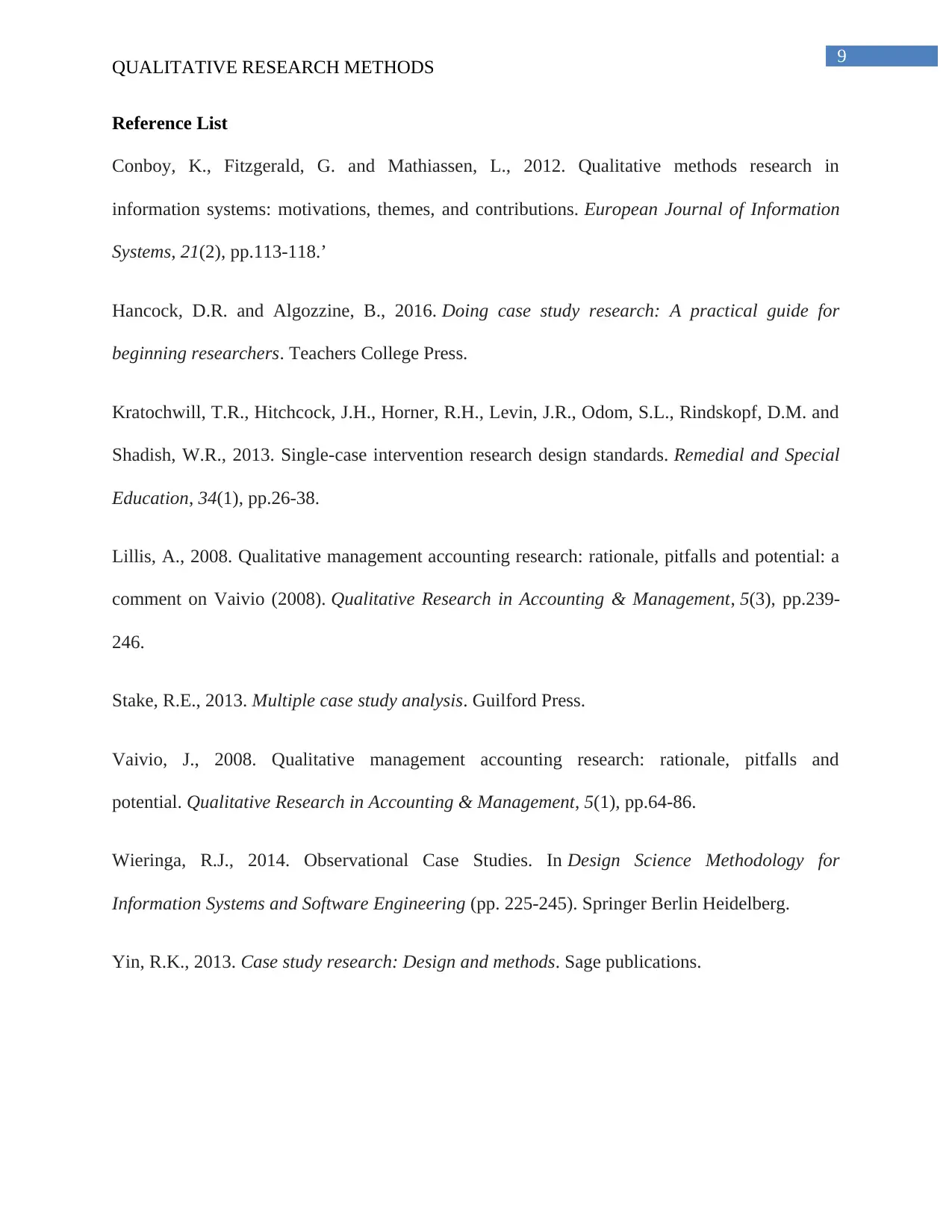
9
QUALITATIVE RESEARCH METHODS
Reference List
Conboy, K., Fitzgerald, G. and Mathiassen, L., 2012. Qualitative methods research in
information systems: motivations, themes, and contributions. European Journal of Information
Systems, 21(2), pp.113-118.’
Hancock, D.R. and Algozzine, B., 2016. Doing case study research: A practical guide for
beginning researchers. Teachers College Press.
Kratochwill, T.R., Hitchcock, J.H., Horner, R.H., Levin, J.R., Odom, S.L., Rindskopf, D.M. and
Shadish, W.R., 2013. Single-case intervention research design standards. Remedial and Special
Education, 34(1), pp.26-38.
Lillis, A., 2008. Qualitative management accounting research: rationale, pitfalls and potential: a
comment on Vaivio (2008). Qualitative Research in Accounting & Management, 5(3), pp.239-
246.
Stake, R.E., 2013. Multiple case study analysis. Guilford Press.
Vaivio, J., 2008. Qualitative management accounting research: rationale, pitfalls and
potential. Qualitative Research in Accounting & Management, 5(1), pp.64-86.
Wieringa, R.J., 2014. Observational Case Studies. In Design Science Methodology for
Information Systems and Software Engineering (pp. 225-245). Springer Berlin Heidelberg.
Yin, R.K., 2013. Case study research: Design and methods. Sage publications.
QUALITATIVE RESEARCH METHODS
Reference List
Conboy, K., Fitzgerald, G. and Mathiassen, L., 2012. Qualitative methods research in
information systems: motivations, themes, and contributions. European Journal of Information
Systems, 21(2), pp.113-118.’
Hancock, D.R. and Algozzine, B., 2016. Doing case study research: A practical guide for
beginning researchers. Teachers College Press.
Kratochwill, T.R., Hitchcock, J.H., Horner, R.H., Levin, J.R., Odom, S.L., Rindskopf, D.M. and
Shadish, W.R., 2013. Single-case intervention research design standards. Remedial and Special
Education, 34(1), pp.26-38.
Lillis, A., 2008. Qualitative management accounting research: rationale, pitfalls and potential: a
comment on Vaivio (2008). Qualitative Research in Accounting & Management, 5(3), pp.239-
246.
Stake, R.E., 2013. Multiple case study analysis. Guilford Press.
Vaivio, J., 2008. Qualitative management accounting research: rationale, pitfalls and
potential. Qualitative Research in Accounting & Management, 5(1), pp.64-86.
Wieringa, R.J., 2014. Observational Case Studies. In Design Science Methodology for
Information Systems and Software Engineering (pp. 225-245). Springer Berlin Heidelberg.
Yin, R.K., 2013. Case study research: Design and methods. Sage publications.
⊘ This is a preview!⊘
Do you want full access?
Subscribe today to unlock all pages.

Trusted by 1+ million students worldwide

10
QUALITATIVE RESEARCH METHODS
QUALITATIVE RESEARCH METHODS
1 out of 10
Related Documents
Your All-in-One AI-Powered Toolkit for Academic Success.
+13062052269
info@desklib.com
Available 24*7 on WhatsApp / Email
![[object Object]](/_next/static/media/star-bottom.7253800d.svg)
Unlock your academic potential
Copyright © 2020–2025 A2Z Services. All Rights Reserved. Developed and managed by ZUCOL.





